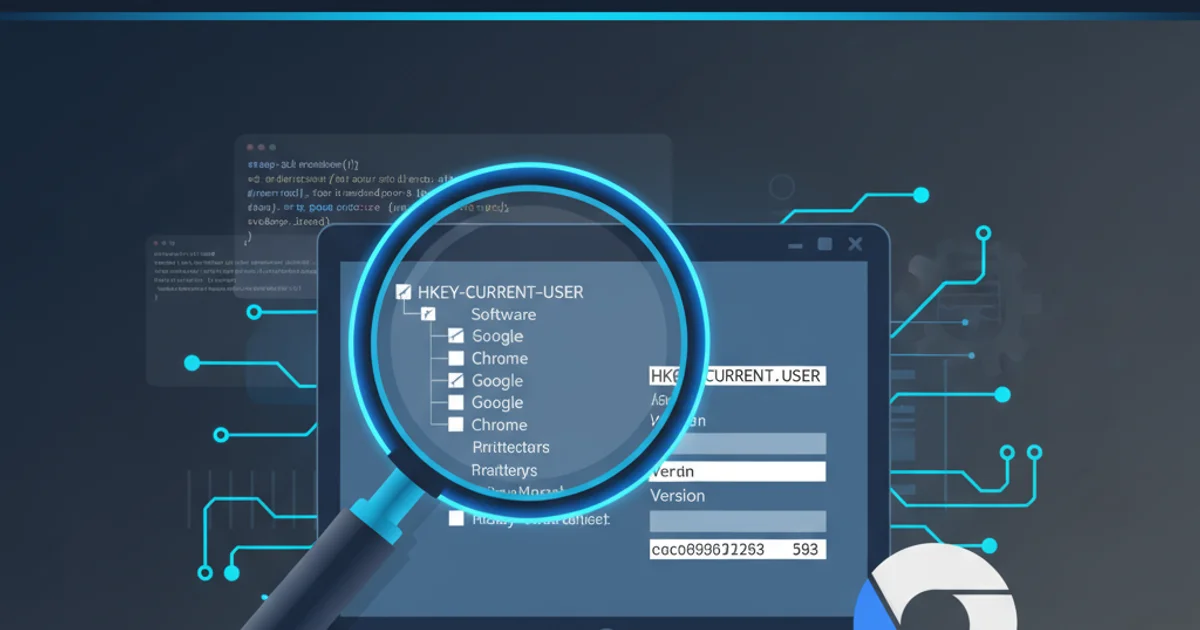Windows Registry location for Google Chrome version
Categories:
Locating Google Chrome's Version in the Windows Registry

Discover how to programmatically or manually retrieve the installed version of Google Chrome on a Windows system using the Registry Editor and PowerShell.
Understanding the installed version of Google Chrome on a Windows machine is crucial for various reasons, including troubleshooting, security auditing, and ensuring compatibility with web applications. While Chrome provides an 'About Chrome' page, accessing this information programmatically or for multiple machines requires a different approach. The Windows Registry serves as a central hierarchical database for operating system and application settings, making it an ideal place to find this data.
Understanding Chrome's Registry Structure
Google Chrome stores its installation and version information within specific keys in the Windows Registry. The exact path can vary slightly depending on whether Chrome is installed for the current user or all users on the system, and the installation type (e.g., stable, beta, dev). Generally, the version information is found under the HKEY_CURRENT_USER or HKEY_LOCAL_MACHINE hives.
flowchart TD
A[Start]
A --> B{"Is Chrome installed for current user or all users?"}
B -->|Current User| C["HKEY_CURRENT_USER\Software\Google\Update\Clients\{GUID}"]
B -->|All Users| D["HKEY_LOCAL_MACHINE\Software\Google\Update\Clients\{GUID}"]
C --> E["Look for 'pv' (Product Version) value"]
D --> E
E --> F[End: Retrieve Chrome Version]Flowchart illustrating the logic for locating Chrome's version in the Windows Registry.
Manual Retrieval using Registry Editor (regedit)
For a quick, one-off check, the built-in Registry Editor (regedit.exe) is the simplest tool. You'll need to navigate through the registry keys to find the relevant Google Chrome entry. The key containing the version is usually identified by a GUID (Globally Unique Identifier) that represents the Chrome installation.
1. Open Registry Editor
Press Win + R, type regedit, and press Enter. Confirm the UAC prompt if it appears.
2. Navigate to the Google Update Clients Key
In the Registry Editor, navigate to one of the following paths:
- For current user installations:
HKEY_CURRENT_USER\Software\Google\Update\Clients - For all user installations:
HKEY_LOCAL_MACHINE\Software\Google\Update\Clients
3. Locate the Chrome GUID
Under the Clients key, you will see several subkeys, each named with a GUID (e.g., {8A69D345-D564-463C-AFF1-A69D9E530F96}). Look for the GUID that corresponds to Google Chrome. You might need to click through a few to find one with a name value of Google Chrome or a pv (product version) value that looks like a Chrome version number.
4. Identify the Version
Once you've found the correct GUID key, look for a string value named pv. The data associated with this value is the installed version of Google Chrome (e.g., 120.0.6099.110).
name value within the GUID's subkeys if available, or by looking for the pv value directly.Programmatic Retrieval using PowerShell
For automation, scripting, or checking multiple machines, PowerShell is an excellent tool. You can query the registry directly and parse the output to get the Chrome version. This method is more robust and scalable.
$chromePathCU = 'HKCU:\Software\Google\Update\Clients'
$chromePathLM = 'HKLM:\Software\Google\Update\Clients'
$chromeVersion = $null
# Check HKEY_CURRENT_USER first
if (Test-Path $chromePathCU) {
$chromeGuids = Get-Item -Path $chromePathCU | Select-Object -ExpandProperty PSChildName
foreach ($guid in $chromeGuids) {
$key = Get-ItemProperty -Path "$chromePathCU\$guid" -ErrorAction SilentlyContinue
if ($key -and $key.pv) {
# A common GUID for Chrome, or look for 'name' property if available
# For simplicity, we'll assume the first 'pv' found is Chrome's version
# A more robust script might check for a 'name' property like 'Google Chrome'
$chromeVersion = $key.pv
break
}
}
}
# If not found in HKEY_CURRENT_USER, check HKEY_LOCAL_MACHINE
if (-not $chromeVersion -and (Test-Path $chromePathLM)) {
$chromeGuids = Get-Item -Path $chromePathLM | Select-Object -ExpandProperty PSChildName
foreach ($guid in $chromeGuids) {
$key = Get-ItemProperty -Path "$chromePathLM\$guid" -ErrorAction SilentlyContinue
if ($key -and $key.pv) {
$chromeVersion = $key.pv
break
}
}
}
if ($chromeVersion) {
Write-Host "Google Chrome Version: $chromeVersion"
} else {
Write-Host "Google Chrome version not found in registry."
}
PowerShell script to retrieve Google Chrome's version from the Windows Registry.
regedit or scripts that interact with the registry. It's recommended to back up your registry before making significant changes.